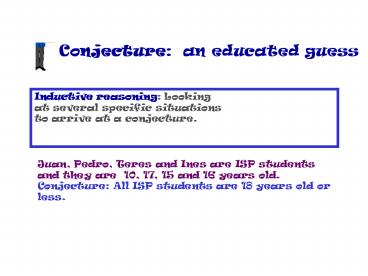Conjecture: an educated guess - PowerPoint PPT Presentation
Title:
Conjecture: an educated guess
Description:
(Application of the law of Syllogism) Law of Syllogism. Law of syllogism: If p q and q r are true conditionals, the p r is also true. ... – PowerPoint PPT presentation
Number of Views:75
Avg rating:3.0/5.0
Title: Conjecture: an educated guess
1
Conjecture an educated guess
Inductive reasoning Looking at several specific
situations to arrive at a conjecture.
Juan, Pedro, Teres and Ines are ISP students and
they are 10, 17, 15 and 16 years old.
Conjecture All ISP students are 18 years old or
less.
2
Counterexample
A conjecture may be true or false
It takes only one false example to show a
conjecture is not true. The false example is
called a counterexample.
Orlando is an ISP student, and he is 19 years
old. Then, not all ISP students are 18 years old
or less.
3
Conditional Statement
Conditional statement (if-then statement)
hypothesis conclusion (p ? q)
Example If we do well on the test we are
going to improve our grade in the
subject.
4
Converse
The converse of a conditional is written by
interchanging the hypothesis and the
conclusion. (q ? p)
Example If we improve our grade in this subject,
then we are going to do well on the test
5
Inverse
Negation the denial of a statement. (?p)
Inverse can be formed by negating both, the
hypothesis and the conclusion. (?p ??q)
Example If we dont do well on the test, then we
are not going to improve our grade in this
subject.
6
Contrapositive
Contrapositive Negating the hypothesis
and the conclusion of the converse of the given
conditional. (no q ? no p)
Example If we dont improve our grade in this
subject, then we are not going to do well on the
test.
7
Postulates
- Through any two points there is exactly one line
- Through any three points not on the same line
there is exactly one plane - A line contains at least two points
- A plane contains at least three points not on the
same line - If two points lie in a plane, then the entire
line containing those two points lies in that
plane - If two planes intersect, then their intersection
is a line.
8
Deductive and Inductive Reasoning
Inductive reasoning uses examples to make a
conjecture or rule. From specific to general.
Deductive reasoning uses a rule to make a
conclusion. From general to specific.
All ISP students are 18 years old or less. Juan
is an ISP student, so he is 18 years old or less.
9
Law of detachment
Law of detachment If p ? q is a true conditional
and p is true, the q is true.
If two lines are parallel, they dont intersect
each other. (True statement)
l
If l and m are parallel, they dont intersect
each other. (Application of the law of
detachment)
m
10
Law of Syllogism
Law of syllogism If p ? q and q ? r are true
conditionals, the p ? r is also true.
If two lines are perpendicular they form right
angles. (True statement) If two lines form
right angles, they divide the plane in four equal
angles. (True statement)
l
m
If two lines are perpendicular they divide the
plane in four right angles. (Application of
the law of Syllogism)
11
Some properties from algebra applied to
geometry
mlt1 mlt1
PQQP
If AB CD, then CD AB.
If mltA mltB, then mltB mltA
If mlt1 mlt2 and mlt2 mlt3, then mlt1 mlt3
If GH JK and JK LM, then GH LM
12
Examples
Name the property of equality that justifies each
statement.
Subtraction property ()
Reflexive property ()
Substitution property ()
Multiplication property ()
Division property ()
13
Example 2
Justify each step in solving 3x 5 7
2
The previous example is a proof of the
conditional If 3x 5 7, 2 then
x3
3x 5 7 2
Given
2(3x 5) (7)2 2
Multiplication property ()
3x 5 14
Distributive property ()
Subtraction property ()
3x 9
Division property ()
x 3
This type of proof is called a TWO-COLUMN PROOF
14
Verifying Segment Relationships
- Five essential parts of a good proof
- State the theorem to be proved.
- List the given information.
- If possible, draw a diagram to illustrate the
given information. - State what is to be proved.
- Develop a system of deductive reasoning. (Use
definitions, properties, postulates, undefined
terms, or other theorems previously proved).
15
Theorem 2.1
Congruence of segments is reflexive, symmetric,
and transitive. Reflexive property AB ?
AB. Symmetric property If AB ? CD, then CD ?
AB Transitive property If AB ? CD, and CD ?
EF, then AB ? EF
Abbreviation reflexive prop. of ?
segments symmetric prop. of ?
segments transitive prop. of ? segments
16
Verifying Angle Relationships
Theorem 2-2 Supplement Theorem If two angles
form a linear pair, then they are supplementary
angles
Theorem 2-3 Congruence of angles is reflexive,
symmetric and transitive. Abbreviation
reflexive prop. of ? lts symmetric prop. of ?
lts transitive prop. of ? lts
17
Theorem 2-4 and 2-5
Theorem 2-4 Angles supplementary to the same
angle or to congruent angles are
congruent Abbreviation lts supp. to same lt or ?
lts are ?
Theorem 2-5 Angles complementary to the same
angle or to congruent angles are
congruent. Abbreviation lts comp. to same lt or ?
lts are ?
18
Theorem 2-6, 2-7 and 2-8
Theorem 2-6 All right angles are
congruent Abbreviation All rt. lts are
? Theorem 2-7 Vertical angles are congruent.
Abbreviation Vert. lts are ? Theorem 2-8
Perpendicular lines intersect to form four right
angles. Abbreviation ? lines form 4 rt. lts































